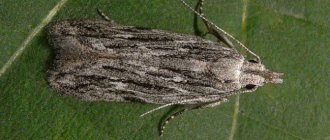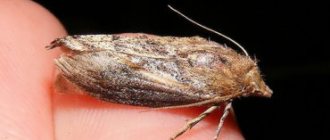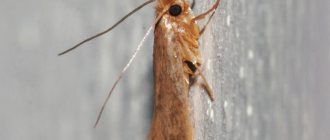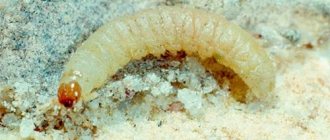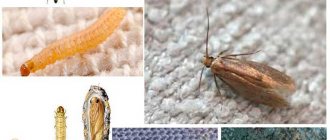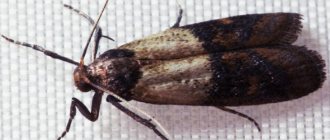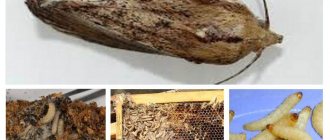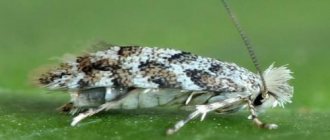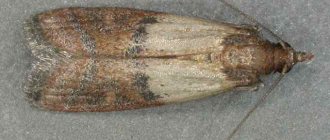Description of fruit moth
The fruit moth is a small and unremarkable butterfly: its body is approximately 1 cm long, and there are horizontal stripes on its gray wings and body, slightly different from the main color. It is easier to notice the pest in the evening, because the insect is characterized by a nocturnal lifestyle. Active years begin in the dark, while during daylight hours the insect prefers to hide in secluded corners, and you can see the fruit striped moth only by accident, for example, by opening a cabinet with supplies where it is hiding.
The life of an insect is short: it lasts on average 2–14 days. The female dies after laying eggs in food. Soon, voracious larvae will hatch from the clutch, which harm the food. Adults do not feed, so they pose a danger only as continuers of offspring.
The difference between the food moth and its clothes relative
To accurately determine the type of pest, you need to know that clothes moths are slightly larger than food pests. Adult kitchen moths lack the pearlescent tint on their wings that is characteristic of clothes moths.
The larvae cannot be identified externally due to their similarity. However, this can be easily done by the way they are fed. Kitchen moth larvae feed on grocery products, and clothes moths lay eggs on the surface of woolen items, hats, fur coats or carpets.
How to get rid of fruit moths? Ways to fight
Fruit moths (larvae) in dried fruits The fight against fruit moths is complicated by one important point - you cannot use chemical insecticides. If, for example, you have bed mites in your house, then it is enough to use special chemicals and clean it. But fruit moths live in food, so this method is excluded.
Harm caused
It doesn’t matter what type (barn moth, cereal moth, flour moth, nut moth, fruit moth) has settled in your kitchen, the harm is the same. In any case, you need to get rid of it as soon as you notice the first butterflies.
Food moths eat almost everything - the larvae are found in cereals, sugar, flour, bread, dried fruits, nuts, dried mushrooms, tea, pasta, seeds, and pet food.
In addition to eating, the larva weaves cocoons from silky threads reminiscent of a spider's web. They look like wool balls and pellets. She sheds her skin several times, changing her skin. Don't forget about defecation products and dead larvae.
All this makes food unsuitable for consumption unless you want to develop severe intoxication, a severe allergic reaction, problems with the immune system, or cause other harm to the body.
Adult butterflies, constantly flickering before your eyes, have the unpleasant property of getting into cups of drinks and pots when cooking.
The longer you wait, the harder it is to get them out later.
Dried fruit protection
You can prevent the appearance of fruit moths if you take care in advance about the proper storage of food. To do this, it is necessary to prevent a sexually mature individual from laying eggs.
How to save dried fruits from moths?
Favorable conditions for moth reproduction are temperature +250C degrees and humidity within 50%. Infection can be eliminated if you prepare food for storage, select containers and determine the location.
Preparation for storage
To prevent moths from infesting dried fruits, you must first check their quality. To do this, you need to sort through them and remove everything that causes suspicion. Then, as a preventive measure against mold and insects, you should additionally dry them in the oven at a temperature of +60-800C for half an hour.
Read also: Making icons with your own hands
Attention! The shelf life of dried fruits is 12 months. After this period they should be disposed of.
Selection of containers
To store dried fruits, you must use hermetically sealed glass containers. After pouring the product into them, you need to put a paper napkin on top, which will absorb moisture.
Determining the storage location
Dried fruits must be stored in a dark, dry place where sunlight does not penetrate. The best option may be a shelf in a pantry or closet.
Protective measures
To preserve dried fruits and protect them from moths, it is necessary to check them regularly throughout the storage period. If stickiness appears, dry it in the oven. Also, to prevent high humidity in the storage area, you should place containers with salt nearby, which will absorb excess moisture.
Prevention
Moths can enter human habitation in a variety of ways. Favorable conditions contribute to the fact that even several adult individuals can breed into entire colonies in the shortest possible time. There is no 100% way to protect your home from moths.
But if you carry out simple prevention and follow the advice, you can reduce this risk to a minimum:
- It is advisable to have a fine mesh on windows and hoods, through which pests will not be able to enter the room.
- You should buy products from trusted stores in order to exclude the possibility of introducing insects from outside. Also, before purchasing, you must visually check the packaging for leaks.
- It is better to store food supplies not in packages, but pour them into glass, tightly closed containers.
- From time to time it is necessary to wipe the shelves with water and vinegar or essential oils.
- The food storage area must be dry and ventilated.
- It is better to store nuts or dried fruits in glass containers that are hermetically sealed.
- And in general, it is better to keep the kitchen and dry fruit storage areas clean. This will prevent the appearance of not only moths, but also other insect pests.
Signs of appearance and damage caused
Usually, the appearance of fruit moths can be noticed when the products can no longer be saved: during the period of intensive growth of the larvae. They are the ones who leave behind dense lumps of excrement, pieces of cobwebs, and gnaw passages in dried fruits or nuts. And in general, it’s hard not to notice white worms scurrying around in a bag or package.
The harm from fruit moths is actually colossal: after all, the insect does not limit itself in food preferences.
Having accidentally appeared in an apartment, it is capable of destroying any food: cereals, cookies, flour. If you store dried fruits together with other food products, you can probably run out of supplies.
Appearance
The fruit moth goes through several stages of development. In everyday life, a moth is usually called a nondescript moth of a gray, brownish color. The size does not exceed 3 cm with open wings. Butterflies are active in the dark, but you can periodically notice moths fluttering during the day.
Moth eggs are extremely small and almost impossible to notice with the naked eye. One female lays up to 100 pieces during the entire life cycle - 3-14 days under favorable conditions.
The larvae are white caterpillars or worms with a dark “muzzle”. The food inside is visible through the translucent covering of the body.
The moth larval phase ends with the formation of a cocoon, pupation. After 2-3 days, a moth appears. There are no significant differences in the appearance of females and males. The fruit moth is pictured below.
Chemicals against kitchen moths
When deciding how to quickly get rid of food moths, you should pay attention to modern chemicals that have a targeted effect against the pest at any stage of its life cycle.
Active drugs can be divided into two types:
- insecticides that can destroy the pest;
- repellents aimed at scaring away adults capable of laying eggs.
Preventive measures
We told you how to deal with pest infestation in the pantry if they have already infested. But to prevent this from happening, it is easier to prevent their occurrence by fulfilling simple requirements:
- To prevent an adult insect (2.5 cm) from entering the room, you need to protect all ventilation windows with fine mesh grilles;
- do not buy goods by weight in the markets; vacuum packaging does not give the insect a chance of survival;
- have a separate storage container for each type of dried fruit;
- constantly check the stock status;
- if possible, immediately after purchase, dry the fruits in the oven with the door open;
- do not make large purchases of dried fruits; small stocks can be stored in the refrigerator;
- The pantry must be frequently ventilated and kept clean and tidy.
Advice. To repel moths, you can use folk remedies: tobacco, dried lavender, and from ordinary means - fumigators or traps.
The food that comes to our table brings us energy - to live and work, vitamins and microelements - to be healthy and beautiful, pleasure - to remain satisfied with our fate. But food with a wormhole can destroy all this forever, ruin it. Someone said, cleanliness is the key to health, so take care of this guarantee, and keep food supplies clean, be healthy.
Features of preparing dried fruits
It is recommended to dry fruits purchased or stored in significant quantities before storing them for long-term storage. To do this, the entire available volume must be reviewed in order to select still wet specimens. Then place them on a paper or wooden surface and leave them to dry outdoors or indoors, choosing a dark place for this. But those dried fruits that look completely dried should also be additionally dried at t° + 22-30° C for 2 days.
Dried fruits must be sorted before packaging
The following manipulation will help determine the readiness of dried fruits for storage. Squeeze a handful of fruits in your palm and then unclench it. If the pieces remain stuck together into one lump and do not crumble, it means that the fruit is still wet and requires further drying. In this regard, you should not store dried fruits with different degrees of moisture together, since they will gain moisture from each other.
Prevention methods
Preserving dried fruits from moths at home is quite difficult, but if you wish, you can avoid troubles.
- Store dried fruits in places with bright sunlight or in a room with low temperatures.
- Periodically sort through the supplies and heat in the oven for a few minutes.
- Wipe cabinets with water and vinegar or place repellents. The moth is afraid of a pungent odor, but with constant presence it gets used to it, so protection should be alternated.
- Place special traps, tablets, cassettes against moths and their larvae next to dried fruits.
You need to begin active actions immediately after discovering at least one moth or caterpillar. Knowing what moths are afraid of, you can quickly eliminate the problem. Otherwise, all food supplies will be contaminated, which will then have to be thrown away. Due attention should be paid to proper storage of dried fruits.
Good evening Olga Valerievna! The biggest nuisance is not the moth itself, since you can simply shake up the dried fruit, but precisely what remains after its habitation.
In any case, it is necessary to sort through everything, shake it up, load it in possible parts into the oven and bake it for 15-20 minutes; if anything remains after the bulkhead, it will die after heat treatment. Good luck!
Olga Valerievna, you are wondering: what to do if there are moths in dried apples? But you don’t ask how to save the apples themselves, from which clouds of moths fly out. It is so.
And you are doing absolutely the right thing. Therefore, you yourself understand that it is no longer possible to save the harvest. Alas…
So, the answer is simple: you need to get rid of dried apples, and as soon as possible - before the insidious fruit moth affects all the other dry products in your house. The moth lays larvae and spreads very quickly...
Do not be upset and treat this experiment as an inevitable bitter experience - we have all gone through similar troubles.
But in the case of the next harvest, you will already know:
• that the apples need to be dried a little longer than this time;
• what is better to choose packaging that is more suitable for dried apples - for example, glass jars with tight lids or brown Kraft paper bags, like these:
www kraftpack ru
• that dry apples should be stored in a dark, dry place and at low temperature.
I don’t know why all the consultants understood the question as a question about saving the moth-damaged apples themselves - and they suggest that you sort them out, wash them and, even more so, roast them together with the deposited larvae.
After all, it is absolutely clear that all these measures are in vain - since, even if you wash each apple slice under a microscope, you will never see the larvae themselves, carefully hidden by the moths inside.
There is only one thing left to do - show determination and throw everything away. What to do now... It's okay.
How to avoid insects
To protect dried fruits from numerous problems such as mold or insects, it is recommended to resort to disinfection and sealed packaging.
The main thing in this matter is to work for prevention, because preventing the pest from reaching your supplies is much easier than later removing it and throwing away the products.
Citrus peels are an excellent moth repellent.
Many insects, including fruit moths, cannot tolerate strong odors, which repel food. Placing bay leaves and lavender leaves nearby will help preserve dried fruits. Furniture can be wiped with fir oil or vinegar, all of which repel pests.
It would also be a good idea to place dried lemon, tangerine or other citrus peels in the same place. The main thing is to keep them separately, and not inside bags or jars of apples, so that the latter are not saturated with other people's aromas.
I also use my grandmother’s method to store it in fabric bags. It is not right?
I can’t say whether it’s right or wrong, but from the height of my experience I will say that I switched to plastic jars with multi-colored lids. And my soul is pleased that everything is in order and the dried fruits are in order.
Doesn't the common food moth eat dried fruits?
He eats, and how. They are tasty and healthy for her. In fact, fruit moths are one of the food varieties.
Frozen storage
With the advent of spacious freezers in our lives, it has become common to keep crops frozen
When frozen, dried fruits lose some of their nutrients, but if there is no other option other than freezing, it is important to know how to store dried fruits in the freezer
No special preparation is required when storing. Dried fruits are placed in small batches in storage containers (food containers or zip-lock bags) and frozen.
Dried fruits can be stored in this way for several years, provided that they are not defrosted and the temperature in the freezer is at -20°C or lower.
Defrosting should only take place at room temperature. It is best to first place the products from the freezer on the top shelf of the refrigerator, and after a few hours at room temperature. You should not defrost the preparations in hot water or the microwave; the fruits will become tasteless and too soft.
How to understand that moths have appeared in dried fruits
It is not difficult to detect insects in dried apples: at the bottom of the container in which they are stored, you can see white worms, light lumps, and the remains of cocoons of moth larvae. Moths are capable of multiplying everywhere: not only in dried fruits, so it will not be difficult to detect traces of its presence inside cabinets, on the walls of furniture or premises.
Moth in dried apples
Pest detection
It is very easy to detect pests in dried fruits. At the bottom of the container in which dried fruits are located, you can most likely find small worms, strange light pellets or traces of cocoons.
However, food moths can breed in other places. It can often be found on walls or cabinets near the feeding area.
Many people often confuse ordinary clothing moths with food moths, although both parasites harm humans: some spoil clothes, others spoil food. There are several varieties of food pests. Most species of food moths have a characteristic light yellow pattern on the wings and are smaller in size.
Moth caterpillars in dried fruits.
What to do if dried fruits are contaminated?
If there are moths in dried apples, you need to take urgent measures to save the remaining stocks. Otherwise, these insects can completely spoil all products. The situation can be corrected only if the damage is minor, otherwise the dried fruits should be thrown away.
Heat treatment
If adult flying individuals were found in the house, but their worms are not visible in the product, then heat treatment can be carried out for drying. To do this, you need to pour it onto a baking sheet and heat it in the oven at +60...70C for 40 minutes.
This pest does not tolerate low temperatures. Therefore, to save drying, you can place it in the freezer and leave it for a day.
Using improvised means
The means at hand will also help to cope with the problem. If there are moths in dried fruits, you need to dispose of spoiled products, and prepare special traps for adult moths. To do this, you will need to mix boric acid with flour in a ratio of 1: 3. Place the resulting mixture in separate containers and place them on the shelves of a cabinet or pantry.
Folk methods of struggle
In the fight against pests, you can also use folk remedies, especially since it is not always advisable to use chemicals in the kitchen next to food.
Effective ways to get rid of moths:
- Lavender. Place bunches of this herb on shelves where dried fruits are stored.
- Citrus. To repel the pest, chop the fruit peel and place it next to the drying container. It needs to be updated periodically.
- Vinegar. Dilute it with water at the rate of 1:3. Wipe the inside of the cabinets where the product is stored with the resulting composition.
Lavender
Popular questions
Housewives often ask the following questions about fruit moths::
- Can you get poisoned if you eat dried fruits infected with moths? By the time the larva becomes an adult, it will have time to change its skin several times, and through its vital activity it will contaminate food. During this time, a lot of feces and old insect skin will accumulate in the dried fruit. If you eat a lot of such foods, food poisoning can occur with serious intoxication of the body.
- Will freezing help? It is not advisable to put food in the refrigerator, since under the influence of low temperatures the larvae of fruit moths simply fall asleep. If you return them to their familiar environment, they calmly come to life and begin their activities. Eggs and larvae die only at high temperatures.
- Are moths afraid of washing powder? Neither ordinary soap nor washing powder are harmful to fruit moths. It can even live in washing powder packets. She is only afraid of the vinegar solution. After treating with this product, the containers can be washed with a solution of laundry soap to remove the specific smell of vinegar.
Fruit moths are a serious pest. If you don’t fight it, it can ruin not only drying, but also neighboring products. This especially happens with large stocks designed for long-term storage. Experienced housewives recommend not making large reserves. It is enough to purchase dried fruits in quantities for 2 weeks.
If moths or larvae appear, immediate measures must be taken to eliminate them. There are many different ways to do this.
It is also important to adhere to preventive measures so that later you do not have to put a lot of effort into exterminating pests.
Lifestyle and reproduction
It is not difficult for fruit moths to get into an apartment: you can hardly notice its clutches in a package with the coveted dried fruits. In nature, it lives in the tropics, so it definitely won’t fly in through a window or ventilation. But in large warehouses, where the assortment is represented by nuts, apples, and dried fruits, this is a frequent guest.
True, given the huge number of related species, some other species that flew through a window or escaped from neighbors through the ventilation system could easily settle in a bag of dried apples or nuts.
Fruit moths are nocturnal, prefer high humidity - at least 60%, and for unhindered reproduction they need a temperature of 28-30 ° C, then at least 3 populations of insects are hatched per year.
One fruit moth butterfly can lay up to 350 eggs, from which white larvae hatch. Quite often they can be found in dried apricots or figs, but home-dried apples are also susceptible to this scourge.
Destruction of moths
Methods of killing moths
The moth is not distinguished by its quick reaction or strong flight abilities. It's easy to slam him. But there is no guarantee that this is the only or last butterfly in the room, so you should play it safe and use effective moth repellents in the apartment and in the kitchen in particular.
- Sticky tapes are hung around the kitchen, anti-moth tablets and special traps are used in cabinets.
- Among the folk remedies, herbs such as lavender, peppermint, chamomile, and geranium will help repel the pest. These plants repel moths with their scent. Orange peels and garlic are also excellent repellents.
- Ventilating the kitchen for 20 minutes every evening during cold periods reduces the activity of moths and creates unfavorable living conditions for them.
- In case of severe infestation of the premises, aerosols and moth sprays are used. Initially, they carry out cleaning to destroy the larvae, wipe down the cabinets, and hide the food in airtight containers. Disinsection is carried out. Use any insecticidal agent - Raptor, Raid, Antimol, Clean House, Dichlorvos. After 20 minutes, ventilate, carry out wet cleaning by adding baking soda and laundry soap to the water. An alkaline environment completely neutralizes the effect of the insecticide.
Where does it come from?
Food moths can get into a person’s home in different ways. Pest larvae may already be in products purchased in stores, since storage conditions in warehouses do not always correspond to the norm. And this leads to the proliferation of the pest. In the absence of dried fruits, moths appear in cereals, flour, tea and nuts. The only things that don't appeal to her are spices and coffee.
Pupae of the pest may also initially be found in fruits that have been used for drying. And since they are subsequently stored in a dry, dark place, such conditions are ideal for further reproduction.
Moths can also fly in through an open window at night. As a result, she finds a favorable place and lays eggs.
Ways to enter the house
An insect enters a person’s home in several ways. Sometimes the owner or housewife brings the pests themselves, but they notice the presence of living creatures in the house after about 2 weeks.
You can list several ways where moths come from in an apartment. How an insect gets into the house:
- Through open windows. The butterfly is active in the dark and is attracted by the light of evening windows and lanterns. It flies into a room, finds a suitable place to lay eggs, and dies a few days later. In most cases, one moth goes unnoticed; the owners learn about the infestation of the apartment after the appearance of voracious larvae.
- In the warm season, pest eggs may end up on apples and pears that people use for drying. Over time, dried fruits are placed in a dark place - a cabinet, closet, pantry, cardboard box, and this is a favorable place for the development of larvae.
- Fruit moths are brought into the house with food from the store. Moths do not always live in dried fruits. In the absence of these products, the moth lays eggs in cereals, flour, tea, and nuts. The moth actively feeds on these products. Only coffee and spices are not attractive. Even in closed containers or sealed bags there may be eggs, larvae and butterflies.
Important!
The life cycle of the fruit moth does not exceed 30 days, of which the eggs develop for three days, the butterfly flutters for only 14 days, the rest of the time is spent parasitizing the larvae, which pose great harm to humans.
Moth in fruit
